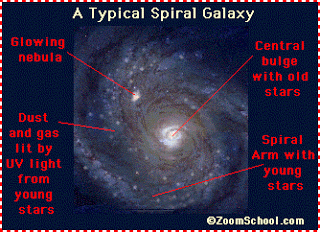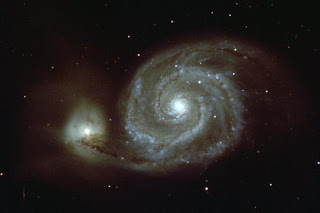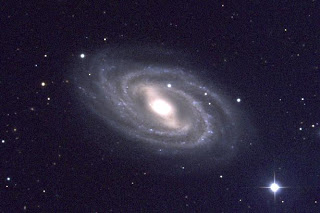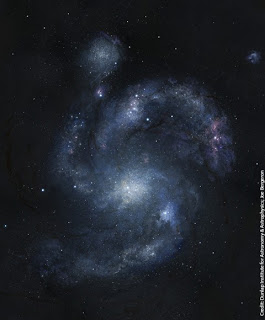Astronomy







 (galaxy BX442, which is 10.7 billion light-years from Earth, and its companion dwarf galaxy (upper left)).
(galaxy BX442, which is 10.7 billion light-years from Earth, and its companion dwarf galaxy (upper left)).
- Picture Of The Day - Nov 5
Picture Of The Day 2012 November , 5 ...
- Irregular Galaxy
Irregular Galaxy ...
- Picture Of The Day Oct - 25
Picture Of The Day October 25 , Thursday The Cone Nebula (NGC 2264) ...
- Elliptical Galaxy
Elliptical Galaxy ...
- Galaxy
Picture Of The Day(Stars and Galaxies) Galaxy ...
Astronomy
Types of Galaxy
Spiral Galaxy
Spiral galaxies have flattened disks with a spiral pattern in the disk. The spiral arms can go all of the way into the bulge or be attached to the ends of a long bar of gas and dust that bisects the bulge. The four distinguishing characteristics of the spirals are: (a) they have more orderly, rotational motion than random motion (the rotation refers to the disk as a whole and means that the star orbits are closely confined to a narrow range of angles and are fairly circular); (b) they have some or a lot of gas and dust between the stars; (c) this means they can have new star formation occuring in the disk, particularly in the spiral arms; and (d) they have a spiral structure
.
Spiral galaxies are sub-classified into ``a'', ``b'', ``c'', and ``d'' groups according to how loose their spiral arms are and how big the nucleus is. The ``a'' group spirals have large bulges and very tightly wound spiral arms and the ``d'' group spirals have almost no bulge and very loose arms. The Milky Way is between the ``b'' and ``c'' groups with a bar, so it is an SBbc-type spiral galaxy. Most spirals are luminous. Some other examples of spiral galaxies are M31 (the Andromeda Galaxy) and M33 (a small spiral in the Local Group).
Spiral arms are regions of stars that extend from the center of spiral and barred spiral galaxy. These long, thin regions resemble a spiral and thus give spiral galaxies their name. Naturally, different classification of spiral galaxies have distinct arm-structures. Sc and SBc galaxies, for instance, have very "loose" arms, whereas Sa and SBa galaxies have tightly wrapped arms (with reference to the Hubble sequence). Either way, spiral arms contain a great many young, blue stars (due to the high mass density and the high rate of star formation), which make the arms so remarkable.
A bulge is a huge, tightly packed group of stars. The term commonly refers to the central group of stars found in most spiral galaxies.
Using the Hubble classification, the bulge of Sa galaxies is usually composed of population II stars, that are old, red stars with low metal content. Further, the bulge of Sa and SBa galaxies tends to be large. In contrast, the bulges of Sc and SBc galaxies are much smaller and are composed of young, blue Population I stars. Some bulges have similar properties to those of elliptical galaxies (scaled down to lower mass and luminosity); others simply appear as higher density centers of disks, with properties similar to disk galaxies.
Many bulges are thought to host a supermassive black hole at their centers. Such black holes have never been directly observed, but many indirect proofs exist. In our own galaxy, for instance, the object called Sagittarius A* is believed to be a supermassive black hole. There is a tight correlation between the mass of the black hole and the velocity dispersion of the stars in the bulge, the M-sigma region
spiral galaxy type Sa ( M104 in virgo)

spiral galaxy type Sb (M81)

spiral galaxy type Sc (M51)

spiral galaxy type SBa (M83 in Hydra)

spiral galaxy type SBb (NGC1365)

spiral galaxy type SBc (M109)
Oldest Spiral Galaxy in Universe Discovered
 (galaxy BX442, which is 10.7 billion light-years from Earth, and its companion dwarf galaxy (upper left)).
(galaxy BX442, which is 10.7 billion light-years from Earth, and its companion dwarf galaxy (upper left)).- Picture Of The Day - Nov 5
Picture Of The Day 2012 November , 5 ...
- Irregular Galaxy
Irregular Galaxy ...
- Picture Of The Day Oct - 25
Picture Of The Day October 25 , Thursday The Cone Nebula (NGC 2264) ...
- Elliptical Galaxy
Elliptical Galaxy ...
- Galaxy
Picture Of The Day(Stars and Galaxies) Galaxy ...
